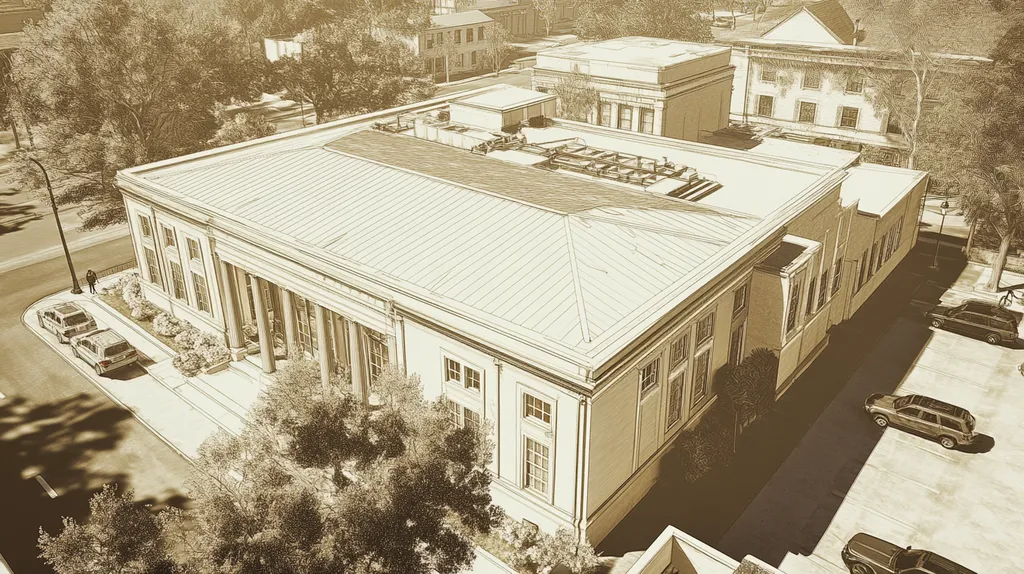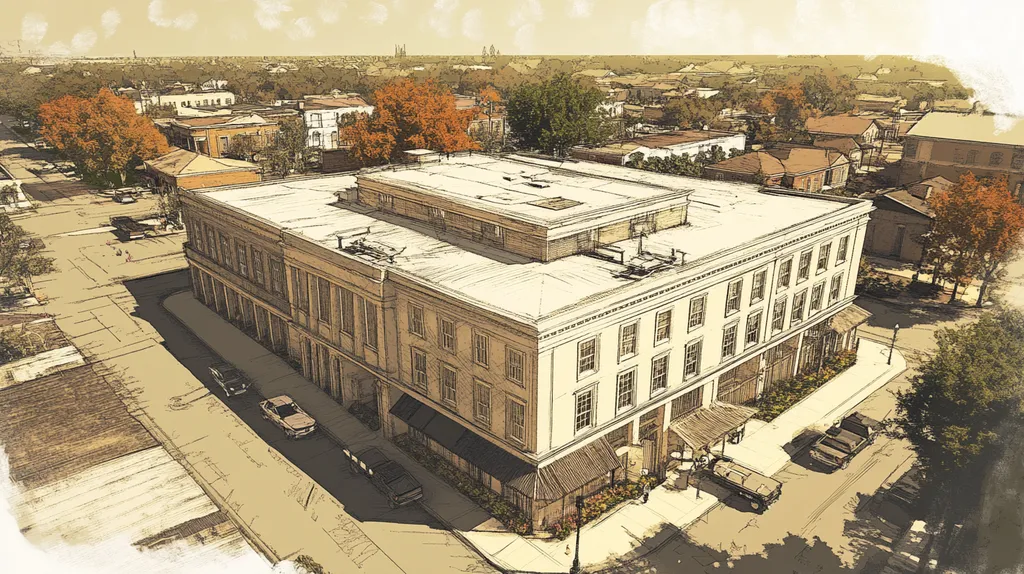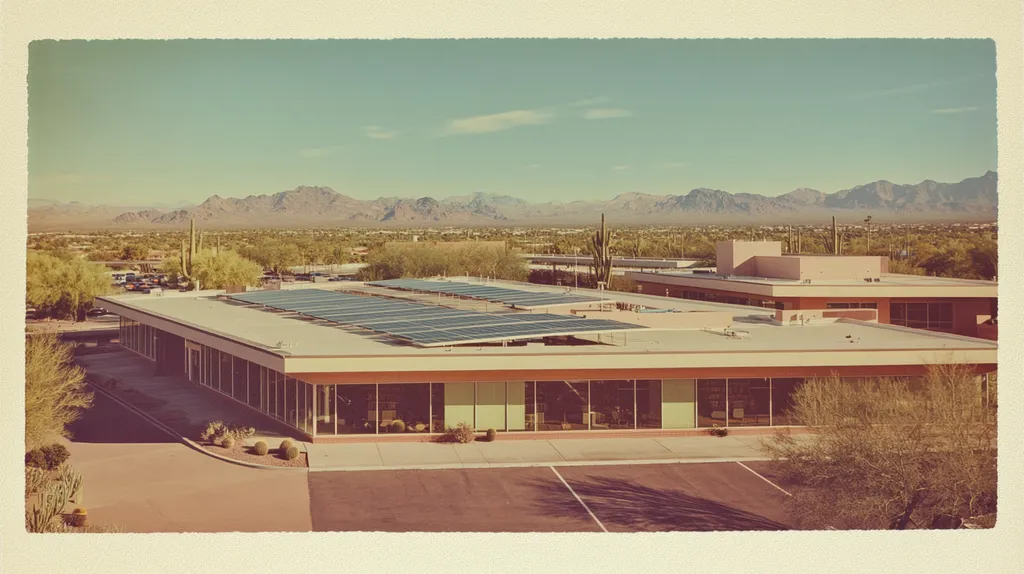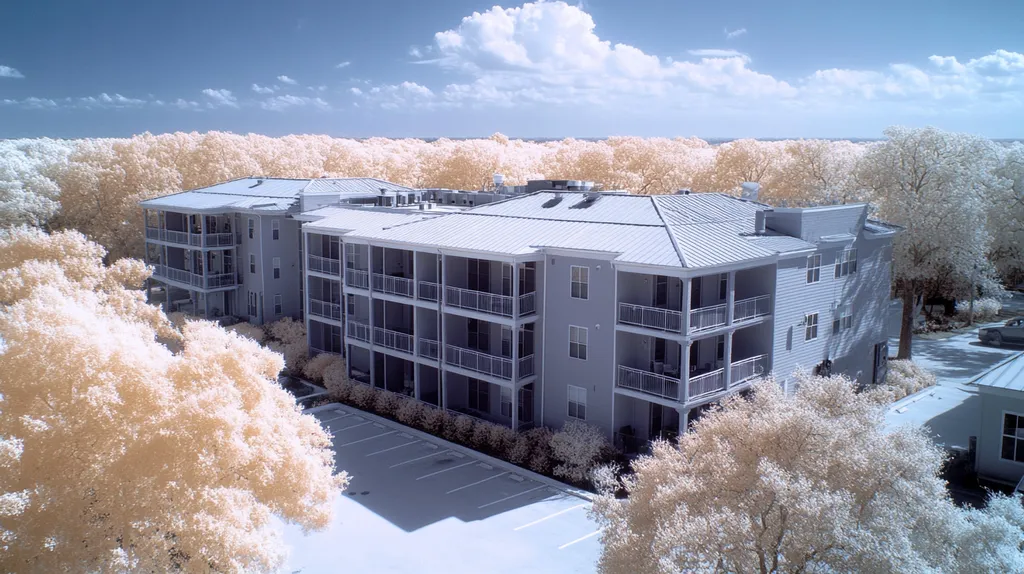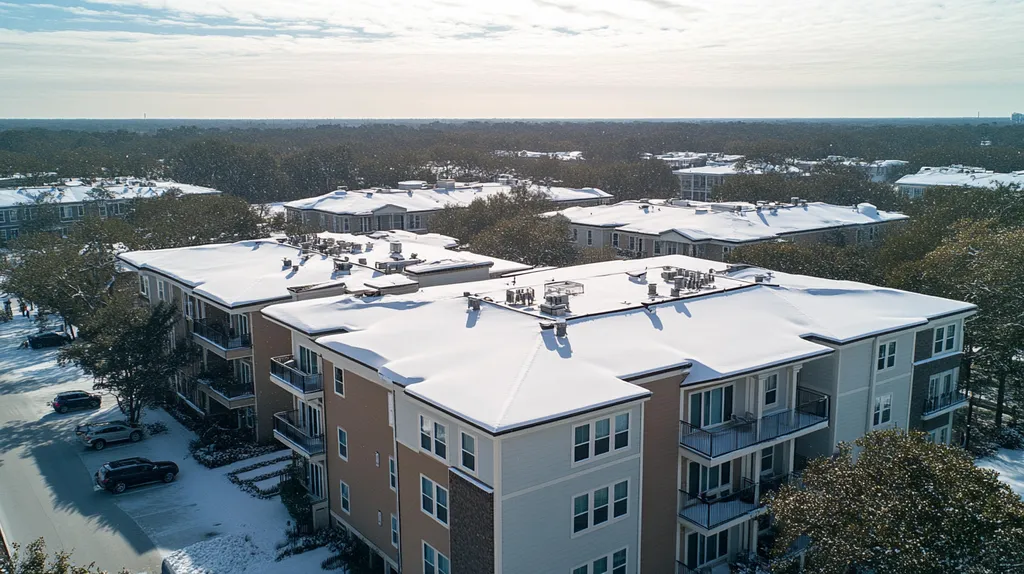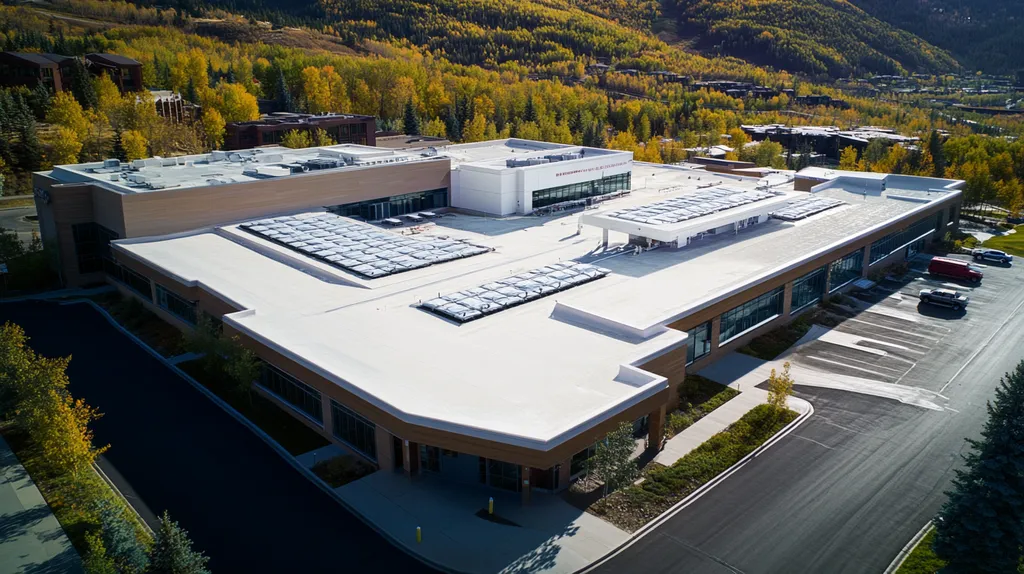Water damage accounts for over 70% of industrial roof failures, resulting in billions of dollars in structural repairs and business disruptions annually. Despite these risks, many facility managers still rely on outdated waterproofing approaches that leave their buildings vulnerable.
Modern coating technologies offer scientifically proven solutions for enhancing roof waterproofing, yet implementation remains inconsistent across the industry. Understanding the science behind these advanced materials is crucial for property owners and facility managers seeking to protect their investments.
This comprehensive guide examines the core principles, applications, and decision factors behind industrial roof coating systems, providing actionable insights for maximizing waterproofing effectiveness.
SECTION 1: THE BASICS EXPLAINED
Industrial roofs are consistently exposed to harsh environmental conditions, making them vulnerable to significant damage. In fact, research indicates that a staggering 70% of roof failures stem from water infiltration. This highlights the urgent need for effective waterproofing measures, particularly through the use of specialized coatings that bolster the structural integrity of industrial roofs. For property owners and facility managers, understanding these coatings and their benefits is essential for safeguarding investments in their facilities.
What It Is (In Plain Language)
Roof coatings are advanced materials that are applied directly to the surface of industrial roofs, forming a protective, waterproof barrier. Unlike traditional roofing methods, which often require complex repairs or complete replacements, coatings offer a non-invasive, efficient solution. They expertly seal leaks and vulnerabilities, significantly enhancing the durability of the underlying roof structures.
There are various types of coatings available, such as elastomeric, silicone, and acrylic, each serving specific purposes with unique benefits, including UV protection and flexibility. This range allows property owners to choose the ideal coating that best meets their roofing needs.
Applying these coatings is a straightforward process that can often be conducted with minimal interruption to daily business operations. This advantage is crucial in ensuring that productivity continues in today’s fast-paced industrial environment.
In summary, roof coatings represent an innovative solution for extending the lifespan of industrial roofs while lowering maintenance costs and improving operational efficiency.
Why It Matters (To Your Building)
Water damage is a primary cause of structural deterioration in industrial buildings. By effectively enhancing waterproofing, coatings are vital in protecting the facility and its valuable assets. A single leak can lead to extensive problems, including mold growth, damage to materials, and significantly inflated repair expenses.
Moreover, efficient waterproofing enhances energy efficiency. When insulation remains dry and intact, the building can maintain better temperature control. This results in lower heating and cooling expenses, contributing to long-term financial savings for the business.
Investing in roof coatings also prolongs the life of existing roofing systems. By preventing moisture intrusion, coatings help maintain structural integrity and postpone the need for costly roof replacements. This proactive approach is critical for maintaining operational efficiency.
With proper care and monitoring, coated roofs can last 10-20 years longer than uncoated roofs, significantly minimizing long-term risks and maximizing the return on investment.
How It Works
Roof coatings operate by creating a seamless membrane that effectively reflects water and deters moisture from penetrating the roofing materials. This is achieved through a chemical makeup that enables the coating to bond securely with the existing roof surface.
Many coatings incorporate ingredients that enhance adhesion and longevity, such as polymers that provide flexibility and weather resistance. This flexibility is crucial in industrial environments, where roofs are subjected to frequent temperature shifts and physical stress.
During the application process, the coating is evenly distributed across the roof surface. As it cures, it creates a waterproof membrane that also shields against UV rays and environmental contaminants. This added layer reduces wear and tear on the roof’s foundational materials, further extending its lifespan.
Regular inspections are essential to ensuring that coatings maintain their effectiveness over time. Property owners should consider local environmental conditions, as they can significantly impact the durability and performance of the coatings.
SECTION 2: PRACTICAL APPLICATIONS
Waterproofing is not merely a routine task; it is essential for preserving the structural integrity of industrial roofs. An alarming 40% of commercial roofing failures result from inadequate waterproofing practices. Coatings provide reliable and effective solutions across various scenarios, ensuring roofs can withstand even the toughest environmental pressures. By understanding when and how to apply these coatings, property owners and facility managers can significantly enhance a roof’s longevity while minimizing repair costs.
Common Uses & Examples
Coatings can be utilized in numerous applications, each one maximizing the waterproofing capabilities of a roof. For instance, elastomeric coatings are especially effective on flat roofs. Their flexibility allows rooftops to expand and contract with temperature fluctuations, preventing the formation of cracks.
Ceramic coatings, known for their ability to reflect harmful UV rays, lower surface temperatures and enhance waterproofing efficiency. This characteristic can lead to energy savings by reducing the reliance on cooling systems. In regions with heavy rainfall, silicone coatings shine with their exceptional adhesion and waterproofing performance.
Choosing the appropriate coating hinges on factors such as the roof type, material, age, and environmental conditions. Facility managers should conduct a thorough assessment to determine the ideal coating product that meets their specific needs.
Appropriately applied coatings not only extend a roof’s lifespan but also protect valuable property investments.
When You Need It Most
The necessity for coatings typically becomes urgent during critical events like seasonal transitions or following extreme weather conditions. For example, winter months can place severe stress on roofs from accumulated snow and ice, making it essential to apply waterproof coatings beforehand to avert leaks and damage.
Routine inspections that reveal small fissures or existing leaks also signal immediate action. Deploying coatings can effectively seal these vulnerabilities, providing a temporary yet meaningful solution until comprehensive repairs can be arranged.
Furthermore, scheduling coatings during regular maintenance is a proactive strategy that anticipates deterioration, significantly reducing the likelihood of major repairs later.
In climates where temperatures fluctuate dramatically, timely application of coatings is vital for maintaining the roof’s integrity, ensuring it can handle the thermal expansion and contraction without compromising its waterproofing characteristics.
Interactions With Other Systems
For optimal effectiveness, coating systems must integrate seamlessly with existing roofing components. Proper compatibility is crucial for ensuring efficient waterproofing. For example, certain coatings may negatively react with older roofing materials, leading to issues like blistering or peeling.
When upgrading insulation, combining it with a flexible membrane coating can significantly enhance the overall performance of the roof. This approach ensures that both elements contribute effectively to waterproofing.
Additionally, coatings play a key role in optimizing drainage systems. By efficiently directing water away from critical areas, they support existing gutters and downspouts, helping to prevent pooling and leaks.
To maximize the benefits of roof coatings, contractors should conduct thorough evaluations of existing roofing systems. This collaborative effort ensures that every component works together to enhance the roof’s waterproofing capabilities.
SECTION 3: KEY TERMINOLOGY DECODED
Grasping the terminology associated with roof coatings is crucial for making sound decisions that protect investments. A staggering 60% of commercial roofing failures occur due to moisture intrusion, underscoring the importance of understanding key terms associated with waterproofing. This section demystifies essential concepts, offering clarity on the role of coatings and their significance in maintaining waterproof integrity. By familiarizing themselves with industry jargon, property owners and facility managers can navigate their roofing assets more efficiently.
Essential Terms Explained
Roof coatings are protective layers designed to improve waterproofing while extending the longevity of roofing systems. These coatings create a seamless barrier that resists water penetration, UV damage, and thermal stress. For instance, the term “elastomeric” refers to the coating’s flexibility, making it ideal for roofs subject to temperature changes. Additionally, understanding “reflectivity” and “opacity” helps property owners assess how effectively a coating repels ultraviolet light and conceals the surface beneath.
Another crucial term is “microbes,” which describes the biological agents that can slowly degrade roofing materials. Selecting the right roof coating can help shield against microbial growth, which could otherwise lead to substantial damage. By unpacking these terms, property owners are empowered to make informed decisions tailored to their unique roofing needs.
Industry Jargon Translated
Industry-specific jargon can often cloud the practical functions of roof coatings. For example, “thermal performance” refers to how well a coating reflects heat, an important factor in reducing energy costs for facilities. This is critical as temperature management directly impacts energy efficiency. Furthermore, the term “weatherability” is vital; it indicates how well a coating withstands environmental elements over time without significant degradation.
Equally important is the “application method,” which defines how coatings are installed. Techniques can include spray application or roller and brush methods, each influencing the coating’s overall effectiveness. Property managers should familiarize themselves with these methods to ensure proper installation and optimal performance of their roofing solutions.
Measurement & Units Simplified
Navigating measurements in roofing may seem complex, but it is essential for informed decision-making. Coating thickness is usually measured in mils, where one mil equals one-thousandth of an inch. This measurement is critical for evaluating the durability of different coatings; thicker coatings generally provide better protection, albeit at a higher cost.
Another important metric is the “coverage rate,” which denotes how many square feet a gallon of coating can cover. This information is vital for budgeting and ensures that sufficient material is procured for the job. By understanding these measurements, decision-makers can effectively plan and execute their roofing projects.
SECTION 4: DECISION FACTORS
In the fast-paced world of industrial operations, the choice of roofing coatings is more than just a routine decision—it’s a critical investment. Leaks can cost businesses tens of thousands of dollars in repairs and lost productivity. Therefore, understanding key factors, such as cost, performance trade-offs, and lifespan, is vital for property owners. Each of these elements plays a pivotal role in the overall viability of roofing systems and their potential return on investment.
Cost Considerations
Budget considerations frequently dominate the decision-making process for roofing coatings. Property owners often grapple with the need to balance initial quality against overall expenses. While lower-cost coatings may seem attractive upfront, they can lead to higher long-term maintenance costs, repairs, and potential loss of operational efficiency.
Considering the total cost of ownership is essential. Investing in higher-quality coatings can yield lower maintenance and repair expenses over time. Additionally, enhanced energy efficiency from better insulation can further offset initial costs.
Exploring financing options or manufacturer incentives can help alleviate budget constraints. Many reputable companies provide warranties and performance guarantees, which improve the financial justification for higher-quality coatings.
Ultimately, neglecting the long-term financial impact can lead to severe repercussions for a facility. A calculated approach to selecting roofing coatings can help prevent future financial burdens and ensure sustained operational effectiveness.
Performance Trade-offs
Each roofing coating has distinct performance features that need consideration. Certain coatings excel in UV resistance, while others are better suited for puncture resistance. Property owners must carefully evaluate these performance traits against the specific operational requirements of their facility.
For example, facilities located in coastal regions may prioritize coatings that resist saltwater corrosion. Choosing the inappropriate coating could lead to premature failures, leaks, and damage that undermine the structural integrity of the building.
Environmental factors also play a significant role in performance. Extreme temperatures, humidity, and UV exposure can all affect how well coatings function over time. A coating with lower performance ratings might deteriorate faster under such challenging conditions.
Testing and certifications are invaluable in assuring coating performance. Collaborating with reputable manufacturers enables property owners to make informed decisions tailored to their unique conditions.
Lifespan & Durability Factors
The lifespan of roofing coatings is a critical factor in the decision-making process. Quality coatings can typically last between 5 and 20 years, largely depending on the material and the quality of installation. Recognizing that a coating’s longevity is closely tied to its durability is vital for property managers.
A coating’s resilience against environmental stresses directly influences its longevity. For instance, coatings designed to accommodate thermal expansion and contraction perform better in environments with significant temperature variation.
Identifying end-of-life indicators is essential for effective maintenance. Regular inspections help detect early signs of wear, enabling timely interventions that prevent severe deterioration.
Investing in durable coatings not only extends the time between necessary reapplications but also promotes energy efficiency and reduces waste, contributing to sustainable building practices. Ultimately, committing to durability serves both the structure and the financial health of the operation.
SECTION 5: COMMON CHALLENGES
Industrial roofs encounter a variety of challenges that threaten their waterproofing effectiveness. Alarmingly, more than 60% of commercial properties report experiencing water infiltration each year, resulting in expensive repairs and building damage. Recognizing these challenges is essential for property owners and facility managers to preserve their roofs’ structural integrity. This section highlights common problems, warning signs to be vigilant for, and preventative strategies to enhance waterproofing.
Frequent Problems & Solutions
Industrial roof coatings often face issues like wear and tear, improper application, and the degrading effects of weather. Each of these challenges can greatly undermine a roof’s capacity to prevent water infiltration.
Wear and tear typically appears as a thinning coating, creating pathways for moisture to reach vulnerable materials beneath. Conducting regular inspections helps identify when a reapplication is needed to restore protective capabilities.
Improper application can result in peeling or bubbling of the coating, particularly if the surface was not adequately prepared beforehand. Engaging qualified professionals for installation is crucial for achieving optimal adhesion and prolonging the coating’s effectiveness.
Weathering effects, such as exposure to UV radiation and severe conditions, can deteriorate coatings over time. Utilizing UV-resistant coatings significantly extends the waterproofing layer’s lifespan and helps reduce maintenance costs (source: TMI Coatings).
Warning Signs To Watch For
Early identification of warning signs is vital for preventing significant damage and costs. Visible cracks or blisters on the coating surface suggest moisture infiltration. Addressing these issues immediately can help circumvent escalating repairs.
Additionally, pooling water on the roof warrants concern. Stagnant water can foster mold growth and degrade roofing materials over time. Implementing a robust drainage solution can greatly alleviate this risk.
Discoloration or fading of the coating can hint at compromised protective qualities. Regular visual inspections focusing on color integrity can provide valuable insight into when re-coating is necessary to retain waterproof performance.
Moreover, undertaking regular inspections after severe weather events is critical. Damage may often be hidden until post-storm assessments, making timely evaluations essential for preserving roofing effectiveness.
Preventative Approaches
Proactive maintenance is key to extending the life of industrial roof coatings. Scheduling routine inspections helps pinpoint minor issues before they escalate into costly repairs. This approach is integral to maintaining the integrity of waterproofing systems.
Utilizing high-quality materials during installation should not be overlooked. Coatings specifically designed to withstand environmental challenges enhance the roof’s resistance to damage and deterioration.
Furthermore, maintaining a clean roof is vital. Accumulated debris can trap moisture and encourage mold growth. A regular cleaning regimen can prevent these adverse effects from taking hold.
Educating building staff on proper roof care and encouraging prompt reporting of issues fosters a culture of vigilance. This collective awareness, combined with diligent maintenance, significantly enhances the longevity of the roof.
SECTION 6: NEXT STEPS & RESOURCES
With costs related to roof leaks and structural water damage on the rise, it is imperative for property owners to take actionable steps to enhance the waterproofing of their industrial roofs. Evaluating suitable coating options is essential for extending roof longevity and safeguarding valuable assets. By asking the right questions and understanding industry standards, property owners can make informed decisions that lead to better outcomes. This section offers guidance on critical inquiries, relevant guidelines, and avenues for further learning.
Questions To Ask Providers
When seeking coating solutions, property owners must equip themselves with a detailed understanding of their options. Critical inquiries include the types of coatings available and their environmental impacts, as well as their anticipated lifespan. Requesting thorough specifications and testing data is essential to confirm that the coatings meet the necessary performance standards.
It is beneficial to ask for references and case studies from the provider’s past projects. This information can provide insight into the reliability of the provider and the real-world efficacy of their coatings. Clarifying warranty details can also inform owners about protections available against potential issues post-installation.
Understanding the installation process is equally important. Owners should inquire about the methods to be employed, the timeline of the project, and how disruptions will be managed to ensure minimal impact on daily operations. Moreover, discussing maintenance plans can significantly enhance the coatings’ effectiveness over time.
Industry Standards & Guidelines
Adhering to industry standards is paramount for maximizing waterproofing effectiveness. The Cool Roof Rating Council (CRRC) provides invaluable guidelines for evaluating coating performance, emphasizing energy efficiency and longevity. Property owners should verify that their selected materials conform to these standards to optimize both performance and environmental sustainability.
Additionally, the National Roofing Contractors Association (NRCA) outlines best practices for roofing installation and maintenance that should inform property owners’ decisions. Familiarity with these standards ensures that applied coatings meet high-performance benchmarks and deliver lasting protection against environmental challenges.
It is vital to consult local building codes, as these often specify particular requirements for materials and installation methods. Compliance not only enhances water resistance but also mitigates legal and financial risks. Finally, seeking certification from manufacturers offers assurance that the products used are of high quality, often signifying extensive testing and proven reliability.
Further Learning Simplified
Property owners interested in expanding their knowledge of industrial roof coatings can access various resources. Online platforms featuring industry-specific webinars and seminars provide insights into the latest innovations and best practices in roofing. Many product manufacturers and roofing associations offer free resources that simplify complex topics for better comprehension.
Industry journals and publications are also excellent learning tools, often featuring case studies and expert analyses that keep owners informed of new trends and technologies. Staying updated can empower property owners to make decisions that result in substantial cost savings and enhanced roof performance.
Networking with peers through forums and trade associations can facilitate valuable exchanges of experiences and advice. Engaging in these communities not only boosts knowledge but also opens doors to collaborative opportunities on roofing projects.
Finally, consulting roofing professionals for tailored guidance can help property owners effectively strengthen their waterproofing strategies. By aligning expert advice with specific facility needs, property owners can ensure their roofing solutions are as effective as possible.
The Bottom Line
With water damage causing over 70% of industrial roof failures and resulting in billions in annual losses, enhanced waterproofing through advanced coatings is no longer optional—it’s imperative for facility survival.
Modern coating technologies offer scientifically-proven solutions that can extend roof life by 10-20 years while significantly reducing maintenance costs and energy consumption.
The key to success lies in selecting appropriate coatings based on specific facility needs, ensuring proper installation by qualified professionals, and implementing regular maintenance protocols.
Property owners who take immediate action to enhance their roofing systems through quality coatings protect not only their physical assets but also their operational continuity and bottom line.
As environmental stresses continue to intensify, the role of advanced waterproofing solutions will become increasingly critical for industrial facility longevity.
FREQUENTLY ASKED QUESTIONS
Q. What are coatings for industrial roofs, and why are they necessary?
A. Coatings are protective materials applied to industrial roofs to enhance waterproofing. They create a seamless barrier to prevent water infiltration, significantly safeguarding building integrity and reducing maintenance costs.
Q. When should coatings be applied to commercial roofs?
A. Coatings should be applied before winter or following severe weather events to prevent leaks. Regular inspections can also reveal small issues that coatings can address immediately to maintain roof integrity.
Q. What key terminology should I understand for industrial roof coatings?
A. Familiarity with terms such as “elastomeric” for flexibility and “reflectivity” for UV resistance is essential. Understanding this terminology aids in making informed decisions about the appropriate coatings for your facility.
Q. What factors should influence my decision on commercial roof coatings?
A. Cost, performance traits, and the coating’s lifespan are crucial factors. An informed assessment of these elements ensures that the selected coating aligns with your operational needs and financial plans.
Q. What common challenges do industrial roofs face?
A. Common challenges include wear from weathering, improper application, and general wear and tear that can compromise waterproofing. Regular maintenance and inspections help to identify issues early on and prevent costly repairs.
Q. What steps should I take for better waterproofing of my industrial roof?
A. Conduct regular inspections, choose high-quality materials, and maintain a clean roof to enhance waterproofing. Proactive measures can significantly protect the structural integrity of your roof and extend its lifespan.
Q. How can property owners find reliable coating providers?
A. Property owners should ask about previous projects, specifications, and warranties. Seeking case studies and references can help assess a provider’s reliability and the effectiveness of their coatings in real-world applications.

